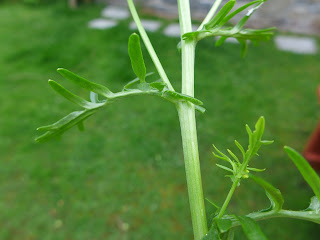There are flowers bursting out everywhere, thanks to the
warm weather and – dare I say it? – summer.
The more obvious bluebells abound near houses, though the true native bluebell (Hyacinthoides
non-scripta)is a scarcity here, as most of the plants you will see are the
garden variety or Spanish Bluebell (Hyacinthoides
hispanica) or a cross between the two (Hyacinthoides x massartiana). For more
information check out this Plantlife article.
 |
| Spanish and hybrid Bluebells by Loch Imrich |
The other obvious blue flowers that are out now are the
Speedwells. These are much smaller than
bluebells . I have already mentioned the Slender Speedwell (Veronica filiformis) in
a previous post. There are several other kinds and I found three of them in my
garden whilst weeding the veg patch. Here they are (after being weeded…)
 |
| Wall Speedwell, Thyme-leaved Speedwell and 2 Germander Speedwell |
The most obvious one is Germander Speedwell (Veronica chamaedrys), which forms large
patches. It has the largest flower and leaf.
 |
| Germander Speedwell |
 |
| Germander Speedwell |
Next is the Thyme-leaved Speedwell (Veronica serpyllifolia) which has a smaller flower with white and
purple on the petals.
 |
| Thyme-leaved Speedwell |
Then, with a tiny deep blue flower, is Wall Speedwell (Veronica
arvensis). I have never seen it in walls but it does like dry ground.
 |
| Wall Speedwell |
Plantlife What is the difference between Spanish and Native Bluebells?


































